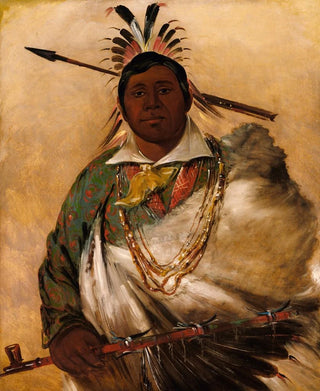Art print | Th-Ke-Nh-Kee Black Coat un chef - George Catlin


View from behind

Frame (optional)
Discover the captivating introduction to the art print "Th-Ke-Nh-Kee Black Coat un chef" by George Catlin
In the rich and complex universe of American art, the work "Th-Ke-Nh-Kee Black Coat un chef" by George Catlin stands out for its narrative depth and commitment to representing Native American cultures. This painting, which captures a precious moment in history, evokes not only the personality of a chief but also the essence of a disappearing people. By contemplating this piece, viewers are invited to immerse themselves in a world where tradition and modernity intertwine, offering a reflection on identity and memory. The art print of this iconic piece allows for rediscovering the beauty and richness of Native American cultural heritage through the lens of a passionate artist.
Style and uniqueness of the work
George Catlin's style is characterized by a realistic and detailed approach, which unfolds with rare elegance in "Th-Ke-Nh-Kee Black Coat un chef." The artist manages to capture not only the physical features of the chief but also the spirit and dignity emanating from his presence. Vibrant colors and meticulously rendered textures testify to attentive observation and a deep understanding of the subjects depicted. Catlin, as an ethnographer and painter, strives to transcend mere visual representation to offer an immersion into the culture of the peoples he portrays. Each brushstroke seems to tell a story, a collective memory, and the work thus becomes a silent witness to the struggles and triumphs of Native American nations.
The artist and his influence
George Catlin, born in 1796, dedicated his life to documenting Native American cultures at a time when they were threatened by colonial expansion. His work is not limited to aesthetics; it is also an act of preservation and resistance. Catlin traveled across the United States, meeting chiefs and members of various tribes, and established an authentic connection with his subjects. His work not only contributed to the recognition of Native American cultures but also influenced many artists and writers who followed. By exhibiting his works in galleries and museums

Matte finish

View from behind

Frame (optional)
Discover the captivating introduction to the art print "Th-Ke-Nh-Kee Black Coat un chef" by George Catlin
In the rich and complex universe of American art, the work "Th-Ke-Nh-Kee Black Coat un chef" by George Catlin stands out for its narrative depth and commitment to representing Native American cultures. This painting, which captures a precious moment in history, evokes not only the personality of a chief but also the essence of a disappearing people. By contemplating this piece, viewers are invited to immerse themselves in a world where tradition and modernity intertwine, offering a reflection on identity and memory. The art print of this iconic piece allows for rediscovering the beauty and richness of Native American cultural heritage through the lens of a passionate artist.
Style and uniqueness of the work
George Catlin's style is characterized by a realistic and detailed approach, which unfolds with rare elegance in "Th-Ke-Nh-Kee Black Coat un chef." The artist manages to capture not only the physical features of the chief but also the spirit and dignity emanating from his presence. Vibrant colors and meticulously rendered textures testify to attentive observation and a deep understanding of the subjects depicted. Catlin, as an ethnographer and painter, strives to transcend mere visual representation to offer an immersion into the culture of the peoples he portrays. Each brushstroke seems to tell a story, a collective memory, and the work thus becomes a silent witness to the struggles and triumphs of Native American nations.
The artist and his influence
George Catlin, born in 1796, dedicated his life to documenting Native American cultures at a time when they were threatened by colonial expansion. His work is not limited to aesthetics; it is also an act of preservation and resistance. Catlin traveled across the United States, meeting chiefs and members of various tribes, and established an authentic connection with his subjects. His work not only contributed to the recognition of Native American cultures but also influenced many artists and writers who followed. By exhibiting his works in galleries and museums






